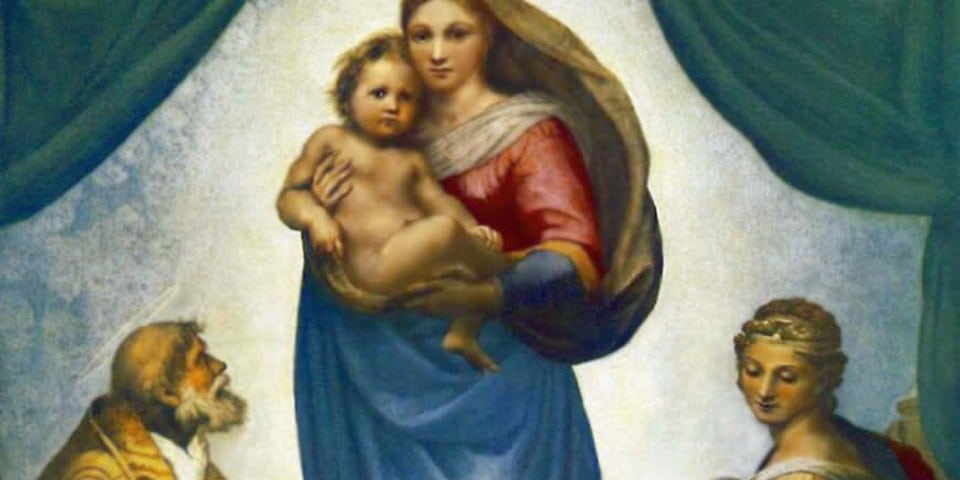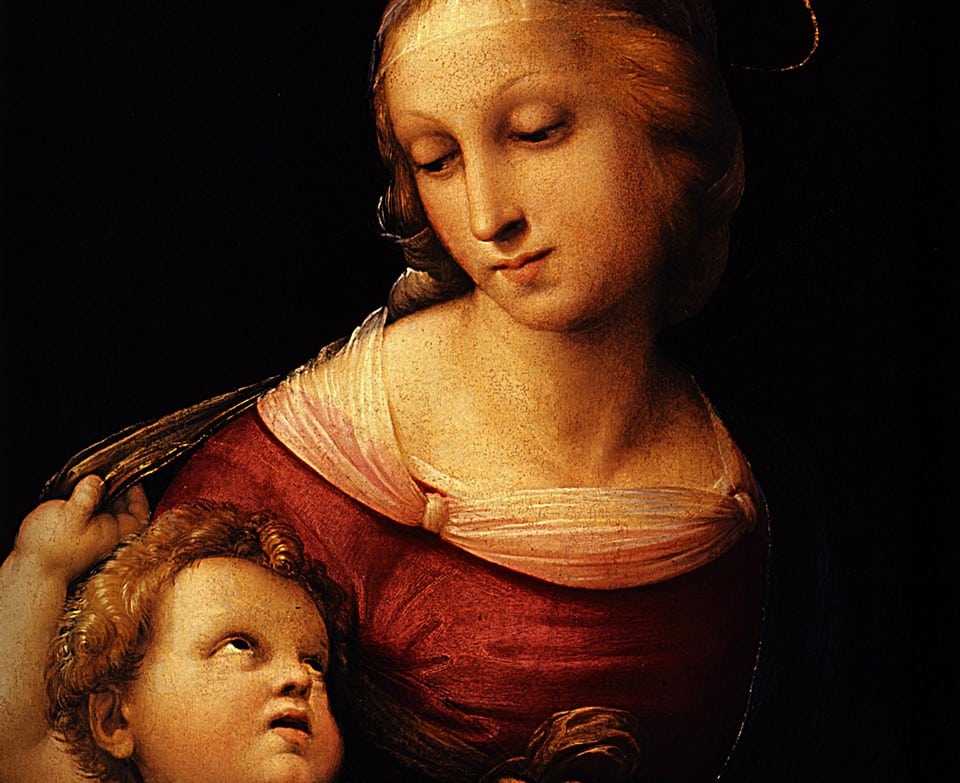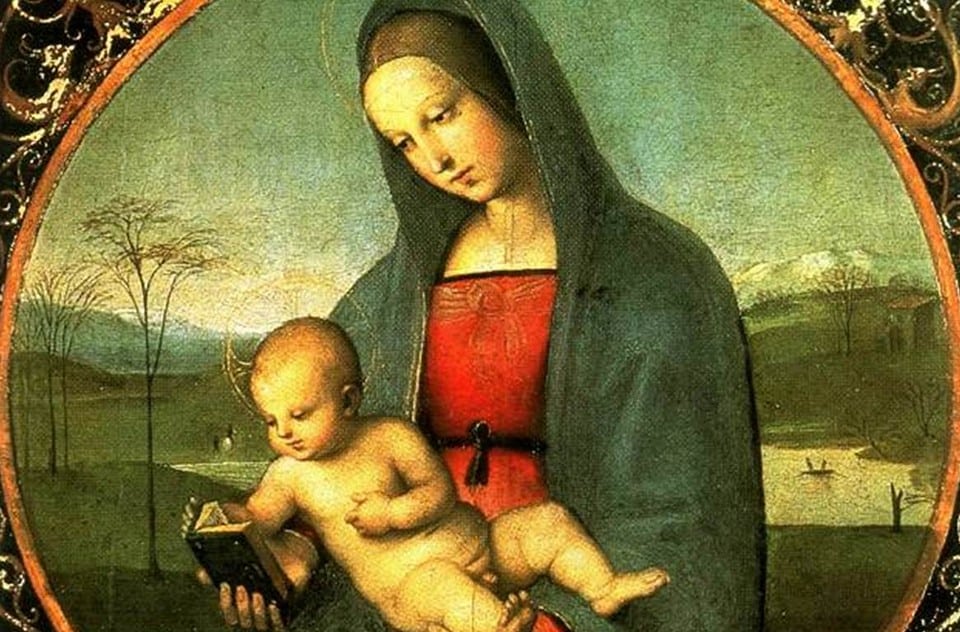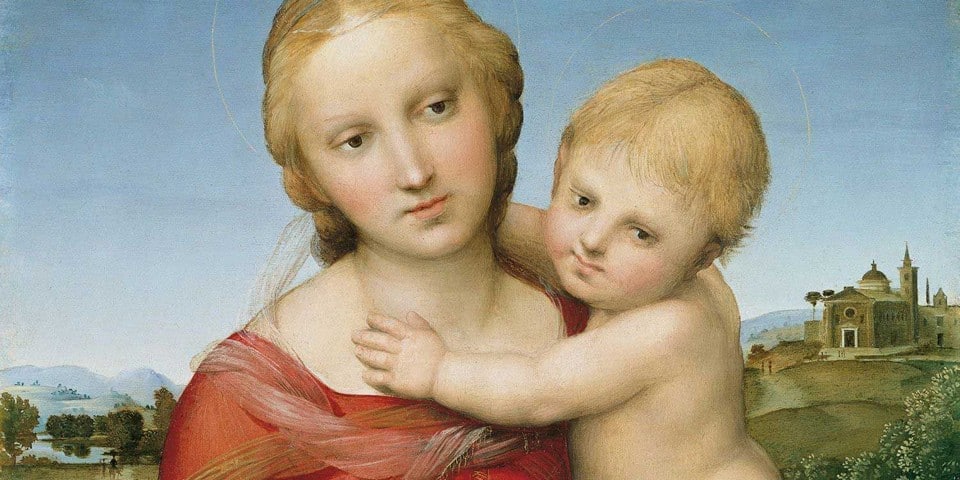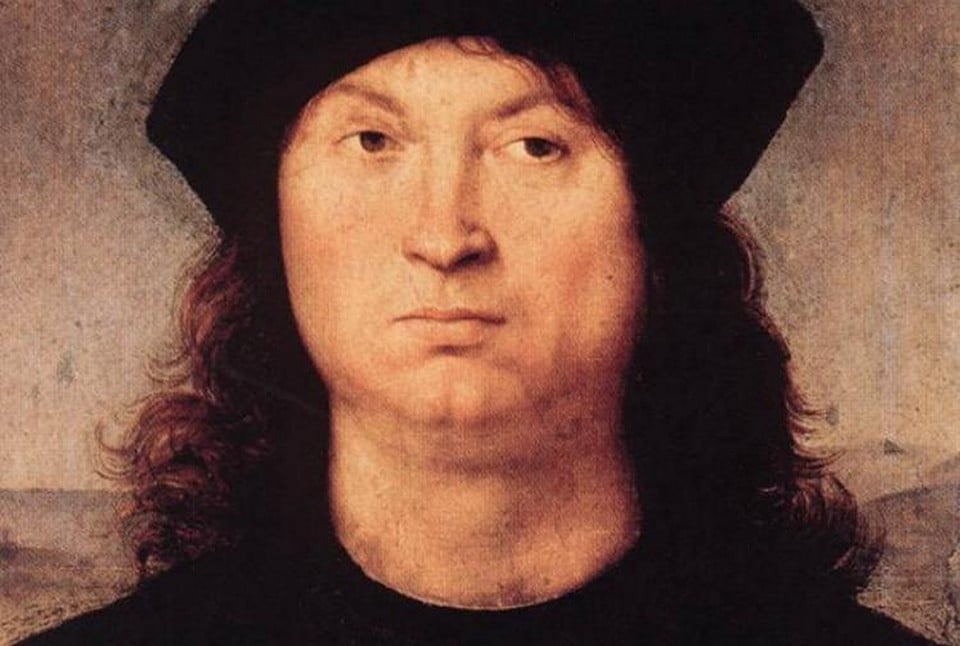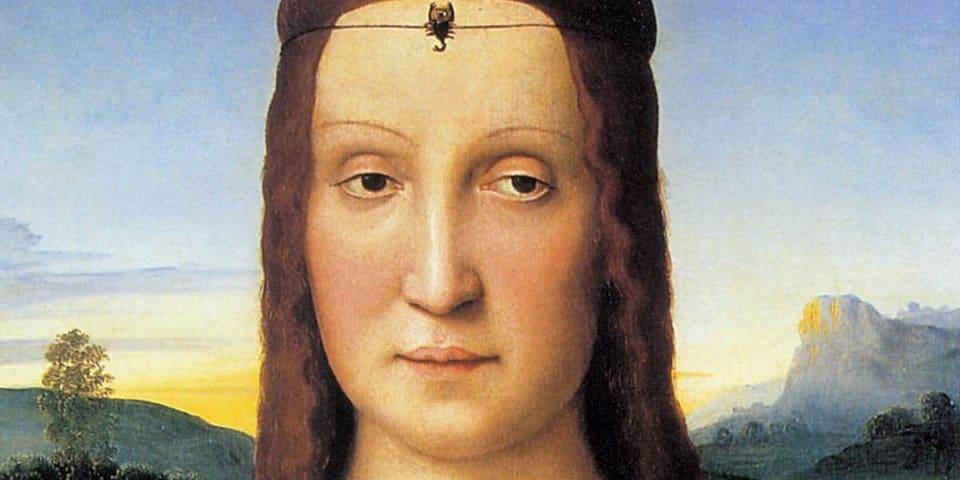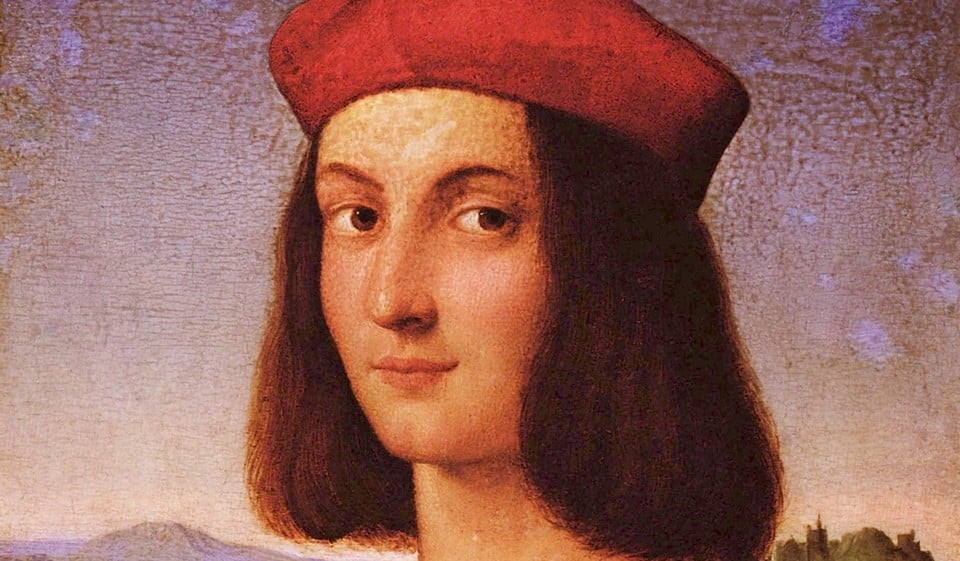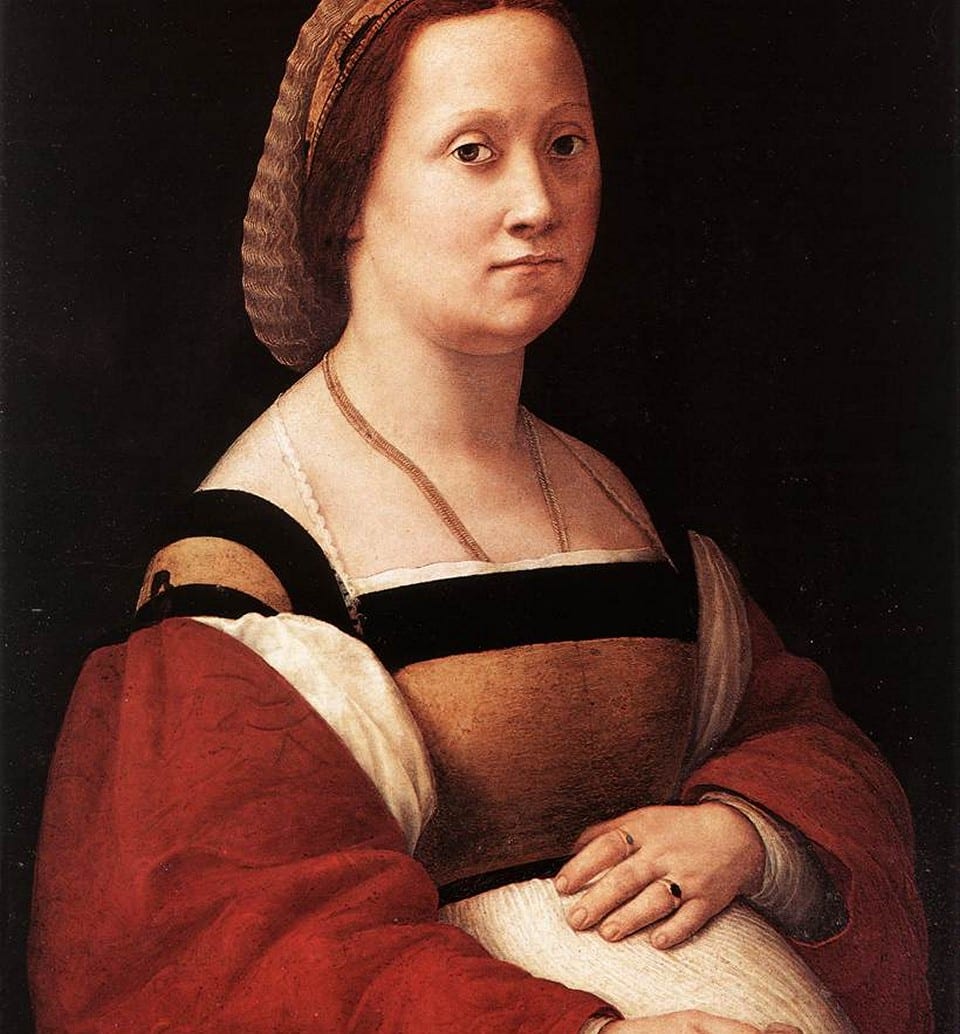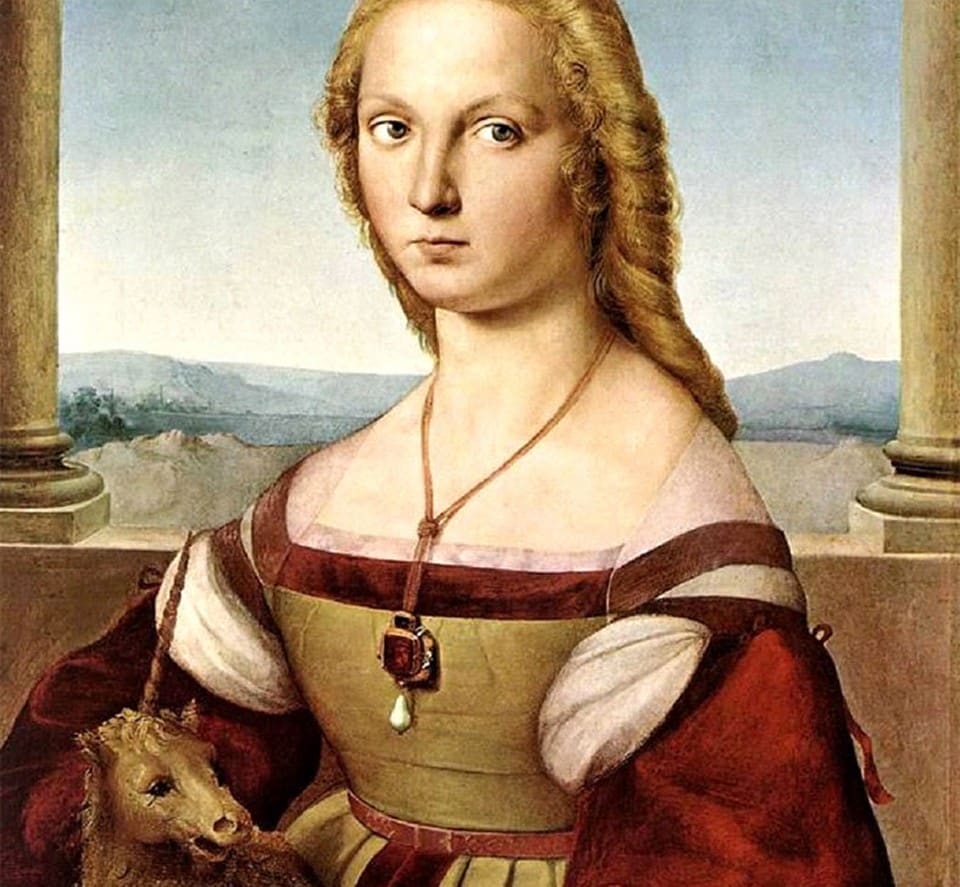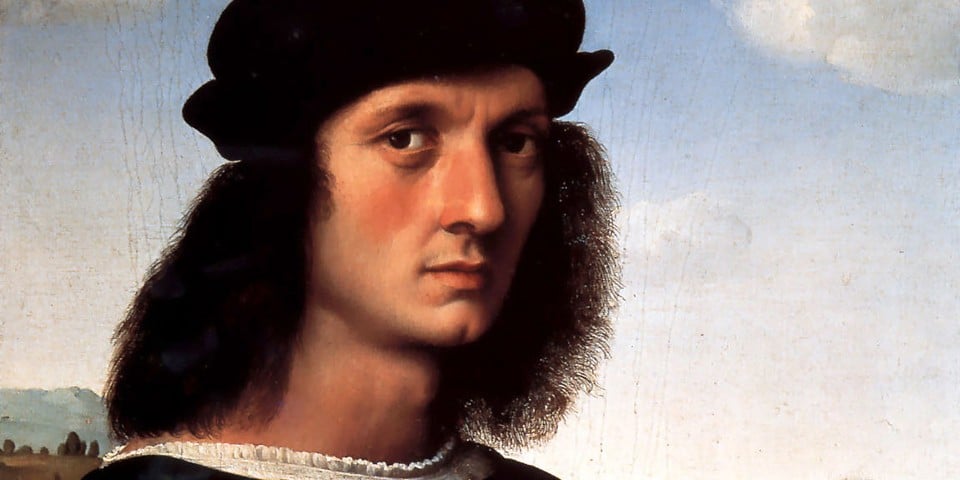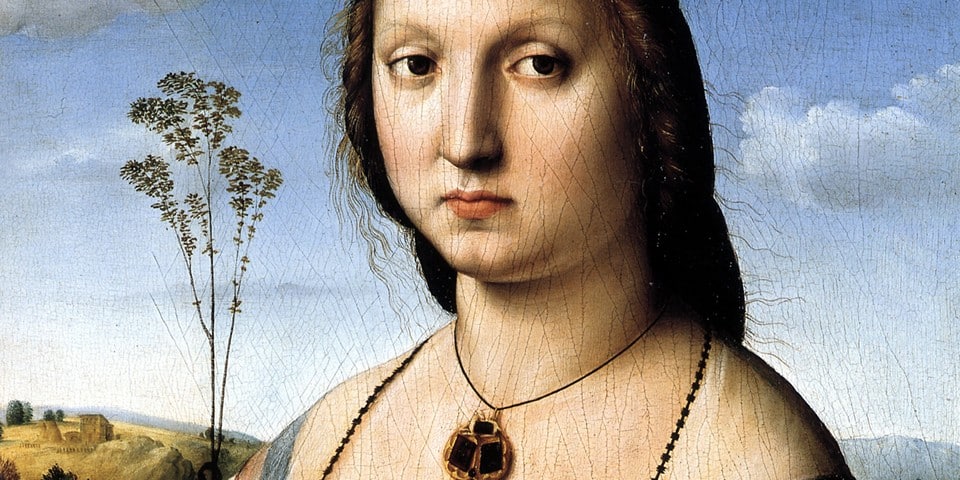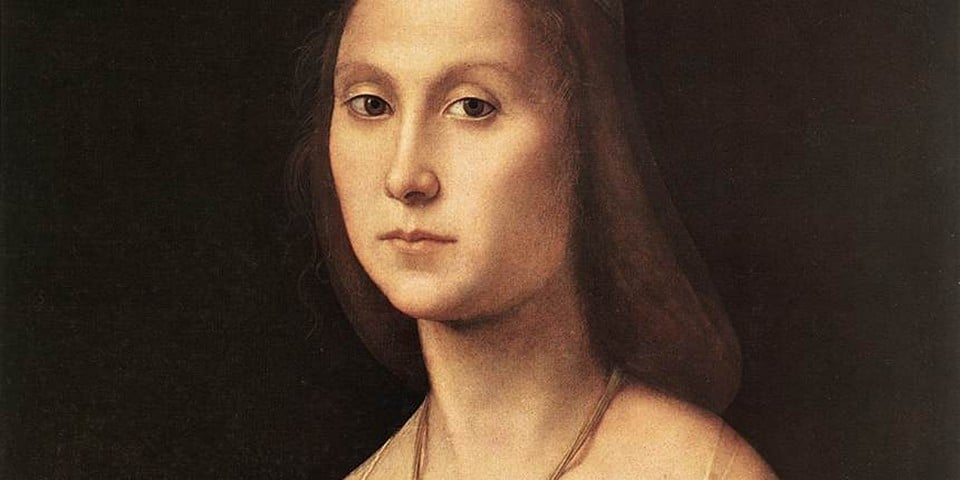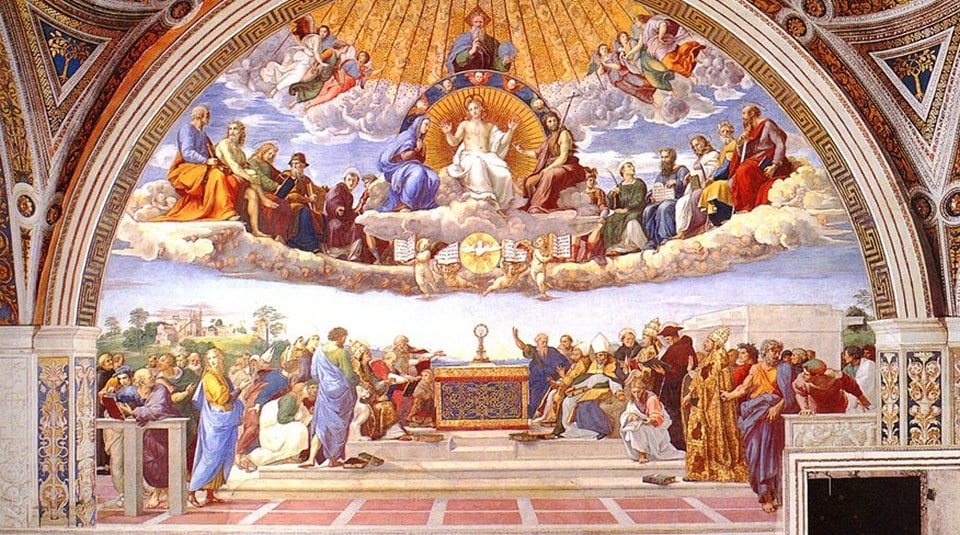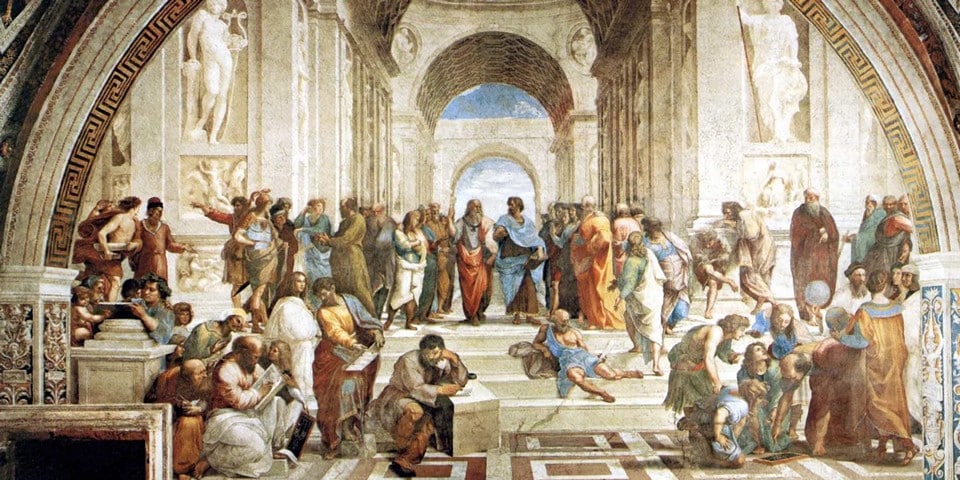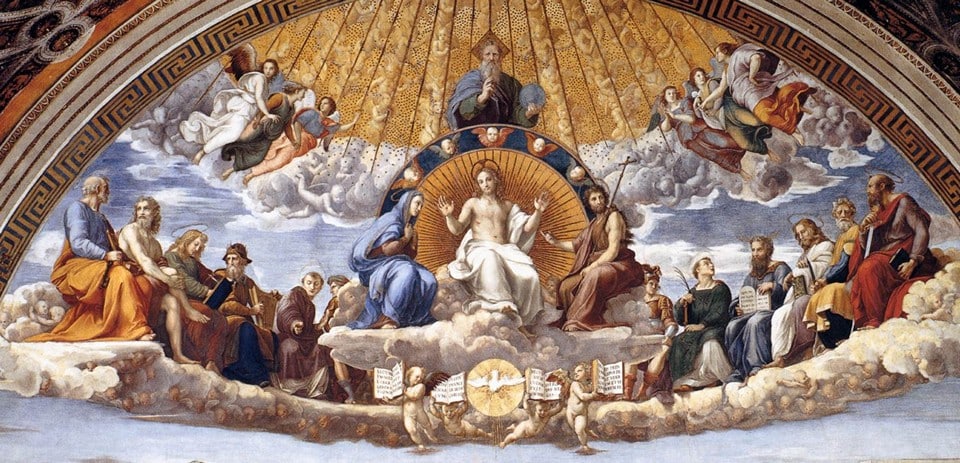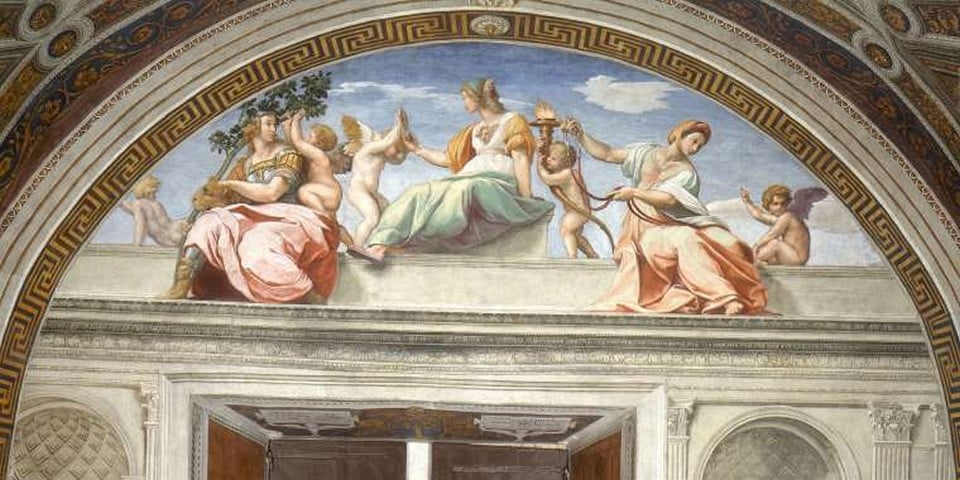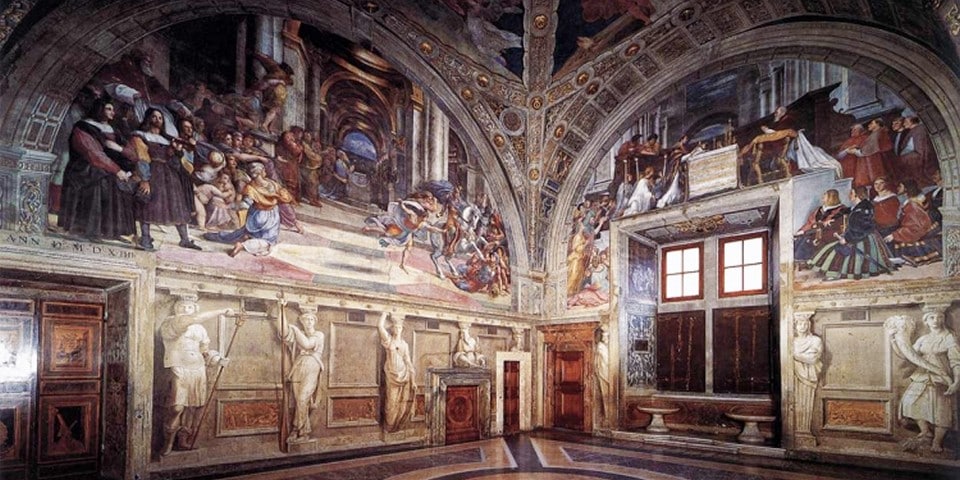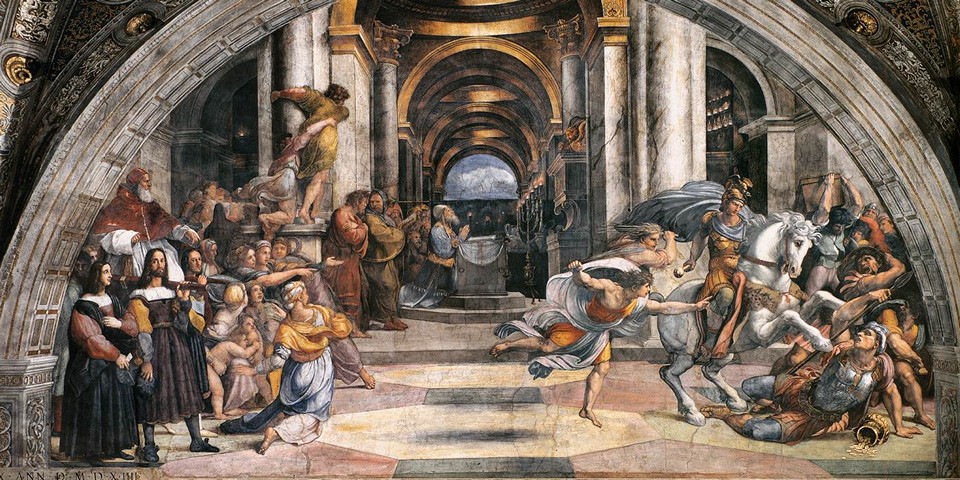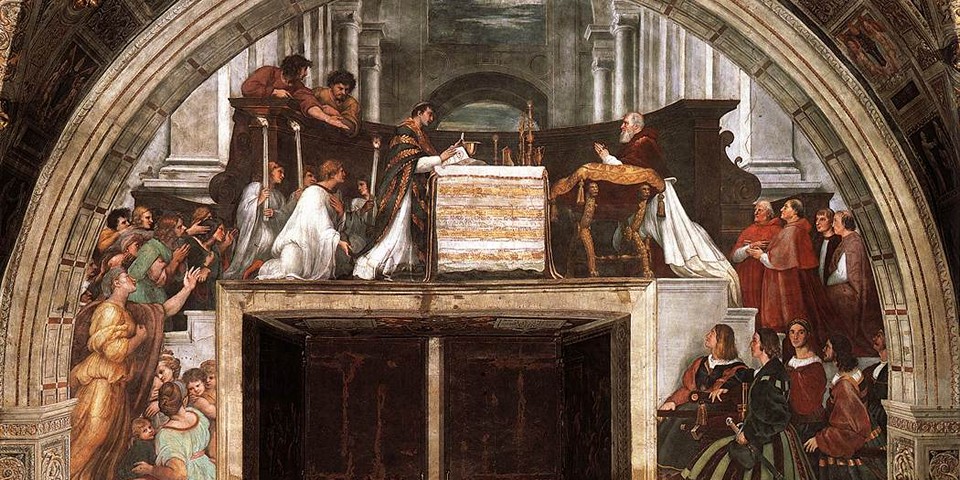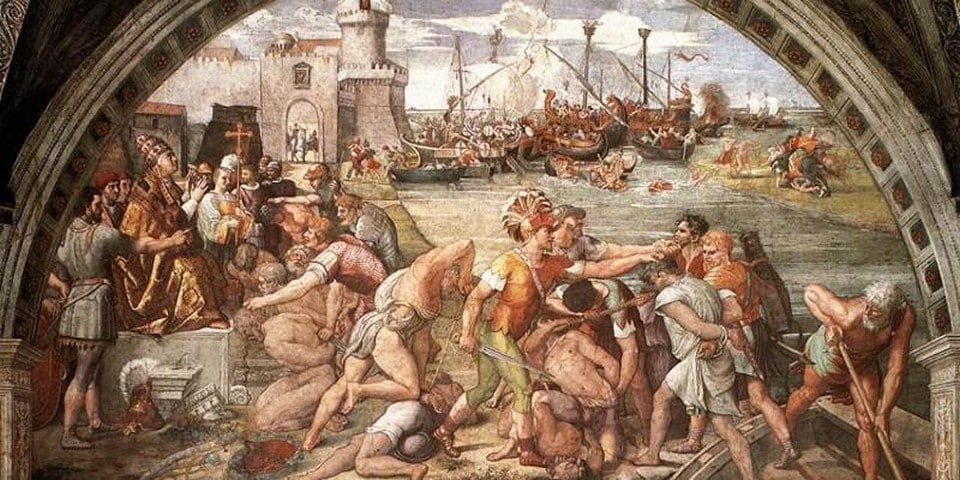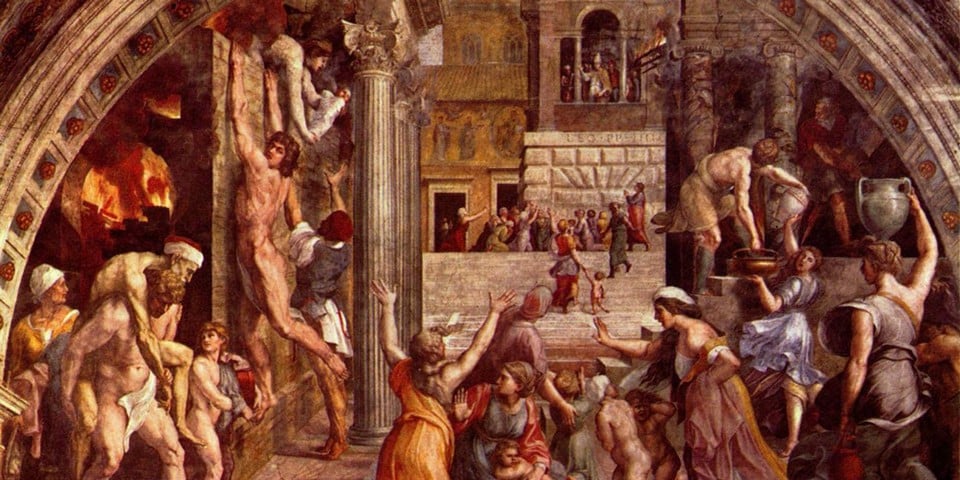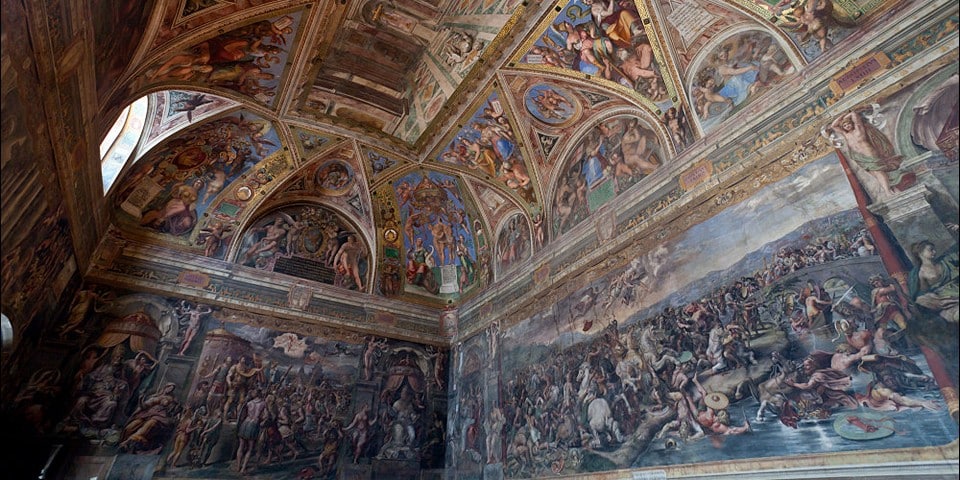Raffaello Santi was an Italian painter, master of graphics and architecture, and representative of the Umbrian Renaissance painting school.
Page Contents
Biography
Raphael was born at three o’clock in the morning on April 6, 1483, in Urbino, Italy, the son of a painter and decorator. He is the cultural and historical center of the Marche region of eastern Italy. Near Raphael’s birthplace are the spa towns of Pesaro and Rimini.
Parents
The father of the future celebrity – Giovanni Santi (Giovanni Santi) worked in the castle of Urbino Duke Federico da Montefeltro (Federico da Montefeltro), and his mother, Margie Charla (Margie Charla), was engaged in housekeeping.
His father noticed his son’s aptitude for painting early on and often took him with him to the palace, where the boy interacted with such famous artists as Piero della Francesca, Paolo Uccello, and Luca Signorelli.
School in Perugia
At the age of 8 years, Rafael lost his mother, and his father brought a new wife Bernardina, who showed no love for another man’s child. At the age of 12, the boy has left a total orphan, having also lost his father. His guardians sent the young talent to study with Pietro Vannucci in Perugia.
Until 1504 Raphael was educated at the school of Perugino, enthusiastically studying the master’s skill and trying to emulate him in everything. Friendly, charming, and devoid of arrogance young man everywhere found friends and quickly adopted the experience of teachers. Soon his works were indistinguishable from those of Pietro Perugino.
Raphael’s first famous masterpieces were paintings:
- “The Betrothal of the Virgin Mary” (Lo sposalizio della Vergine), 1504, exhibited at Milan’s Pinacoteca di Brera;
- “Madonna Connestabile” (Madonna Connestabile), 1504, belongs to the Hermitage (St. Petersburg);
- “Sogno del cavaliere, 1504, exhibited at the National Gallery in London;
- “Tre Grazie, 1504, exhibited at the Musée Condé, Château de Chantilly, France.
The work bears the strong influence of Perugino; Raphael began to create his own style somewhat later.
Life in Florence
In 1504 Raphael Santi moved to Florence, following his teacher Perugino. Thanks to his teacher, the young man met the architectural genius Baccio d’Agnolo, the outstanding sculptor Andrea Sansovino, the painter Bastiano da Sangallo, and his future friend and protector Taddeo Taddei. A meeting with Leonardo da Vinci significantly impacted Raphael’s creative process. A copy of Leonardo da Vinci’s Leda and the Swan has survived to this day (unique in that the original itself has not survived).
Under the influence of new teachers Raphael Santi, during his stay in Florence, creates more than 20 Madonnas, investing them with his longing for the love and affection missing from his mother. The images breathe with love, tenderness, and refinement.
In 1507 the artist took a commission from Atalanta Baglióni, whose only son had died. Raphael Santi created the painting La Deposizione, his last work in Florence. Today, this work of art can be seen in the Galleria Borghese in Rome.
Life in Rome
In 1508, Pope Julius PP. II, Giuliano della Rovere, invited Raphael to Rome to paint the old Vatican Palace. From 1509 until the end of his days, the artist worked in stanzas, investing all his skill, all his talent and all his knowledge.
When the architect Donato Bramante died, Pope Leo X, known as Giovanni Medici, appointed Raphael as lead architect in the construction of the Basilica di Sancti Petri in 1514, and in 1515 he also became the keeper of the treasures. The young man took on the responsibility of enumerating and preserving the monuments of ancient Rome. For the Temple of St. Peter Raphael drew up another plan and finished the construction of the courtyard with loggias.
Other architectural works by Raphael:
- Church of Sant’Eligio degli Orefici (Chiesa Sant’Eligio degli Orefici), erected on the street of the same name in Rome, began in 1509.
- La cappella Chigi of the Basilica of Santa Maria del Popolo, on Piazza del Popolo. The building began in 1513, finished by Giovanni Bernini in 1656.
- Palazzo Vidoni-Caffarelli, in Rome, is located at the junction of Piazza Vidoni and Corso Vittorio Emanuele. Construction began in 1515.
- The Palazzo Branconio dell’Aquila, now destroyed, stood in front of St. Peter’s Basilica. Construction was completed in 1520.
- The Palazzo Pandolfini in Florence, on via San Gallo, was built by Giuliano da Sangallo based on designs by Raphael.
Pope Leo X was afraid that the French might lure the talented artist, so he tried to give him as much work as possible, not stingy with gifts and praise. In Rome, Raphael Santi continued to paint Madonnas, not departing from his favorite subject of motherhood.
Personal life
Raphael Santi’s paintings brought him not only famous as an outstanding artist but also a lot of money. He never lacked both the attention of the monarchs and the financial means.
During the reign of Leo X he acquired a magnificent house in the antique style, built on his project. However, his patrons’ multiple attempts to marry the young man led to nothing. Raphael was a great admirer of female beauty. At the initiative of Cardinal Bibbiena, the artist was engaged to his niece Maria Dovizi da Bibbiena, but the wedding did not take place, the maestro did not want to tie himself to marriage. The name of one famous mistress of Raphael – Beatrice (Beatrice) of Ferrara (Ferrara), but most likely, she was an ordinary Roman courtesan.
The only woman who managed to win the heart of a wealthy lover, was Margherita Luti (Margherita Luti), daughter of baker, nicknamed Fornarina (La Fornarina).
The artist met the girl in the garden of Chigi while looking for an image for Cupid and Psyche. The thirty-year-old Raphael Santi was painting Villa Farnesina in the Trastevere district of Rome, owned by his rich patron, and the beauty of the seventeen-year-old girl was a perfect match for the image.
The girl’s father for 50 gold pieces allowed his daughter to pose for the artist, and later for 3000 gold pieces he allowed Raphael to take her with him. For six years the young people lived together, Marguerite never ceasing to inspire her admirer with more and more masterpieces, among them:
- “Sistine Madonna” (“Madonna Sistina”), Old Masters Gallery (Gemäldegalerie Alte Meister), Dresden, Germany, 1514;;
- “Donna Velata” (“La Velata”), Galerie Palatine, Palazzo Pitti, Florence, 1515;
- “La Fornarina” (“La Fornarina”), Palazzo Barberini, Rome, 1519.
After Raphael’s death, the young Marguerite received life maintenance and a house. But in 1520, she became a novice in a convent, where she subsequently died.
Death
Raphael’s death left many mysteries. According to one version, the artist, weary from his night’s adventures, returned home in a weakened state. Doctors were supposed to support his strength, but they administered bloodletting, which ruined the sick man. According to another version, Raphael caught a cold while excavating in the underground burial galleries.
On April 6, 1520, Maesto died. He was buried in the Pantheon with proper honors. Raphael’s tomb can be seen on a private tour of the sights of Rome at dawn.
Madonnas
Imitating his teacher Pietro Perugino, Raphael painted a gallery of forty-two paintings of the Virgin and Child. Despite the variety of subject lines, the works are united by the touching beauty of motherhood. The lack of maternal love is transferred to the canvases by the artist, reinforcing and idealizing the woman anxiously protecting the angel baby.
Raphael Santi’s first Madonnas were painted in the quattrocento style, common during the early Renaissance of the 15th century. The images are stiff and dry, the human figures are portrayed strictly frontally, the gaze is fixed, the faces are calm and solemnly distracted.
The Florentine period introduces feelings to the images of Our Lady, anxiety and pride in her child. The landscapes in the background become more complex, and the interaction of the characters depicted is evident.
In later Roman works, the beginnings of Baroque (barocco) can be perceived, feelings become more complex, poses and gestures far from Renaissance harmony, the proportions of figures are elongated, and gloomy tones predominate.
Below are the most famous paintings and their descriptions:
Sistine Madonna
The Sistine Madonna (Madonna Sistina) is the most famous of all the images of Our Lady measuring 2 m 65 cm by 1 m 96 cm. The image of the Madonna is taken from the 17-year-old Margherita Luti, daughter of a baker and mistress of the artist.
Mary, descending from the clouds, carries in her arms an unusually serious infant. They are greeted by Pope Sixtus II (Sixtus II) and Saint Barbara. At the bottom of the painting are two angels, presumably leaning on a coffin lid. The angel on the left has one wing. The name Sixtus is translated from Latin as “six” and the composition consists of six figures, the three principal figures forming a triangle with the angels’ faces in the form of clouds as a background. The canvas was painted for the altar of the Basilica of St. Sixtus in Piacenza in 1513. From 1754 the work was exhibited in the Old Masters Gallery.
Madonna and Child
Madonna di Casa Santi” is another name for the 1498 Madonna of the House of Santi. It was the artist’s first reference to the image of Our Lady.
The fresco is kept in the house where the artist was born, in Via Raffaello in Urbino. Today the building is called the Casa Natale di Raffaello (House Museum of Raphael Santi). The Madonna is depicted in profile, she is reading a book mounted on a stand. In her arms is a sleeping infant. The mother’s hands are supporting and gently stroking the child. The poses of the two figures are natural and relaxed, the contrast of dark and white colors setting the mood.
Madonna Granduca
Madonna del Granduca is Raphael’s most enigmatic work, completed in 1505.
Her preliminary sketch clearly indicates the presence of a landscape in the background. The drawing is preserved in the Cabinet of Sketches and Studies in the Galleria degli Uffizi, Florence.
An X-ray of the finished work confirms that the painting originally had a different background. Paint analysis indicates that the top layer on the painting was applied 100 years after its creation. Presumably, it could have been done by the artist Carlo Dolci, owner of the Madonna Granduca, who preferred the dark background of religious images.
In 1800 Dolci sold the painting to Duke François III as it stands today. The title “Grand Duca” receives the Madonna after the name of the same owner (Grand Duca – Grand Duke). The painting measures 84 cm by 56 cm and is displayed in the Galerie Palatine of the Palazzo Pitti, in Florence.
Madonna Bridgewater
Madonna Bridgewater’s resemblance to her wife, Natalia Nikolaevna A. С. Pushkin noticed it in the summer of 1830, when he saw a copy of the picture, created in 1507, in a bookshop window on Nevsky Prospect.
It is another enigmatic work by Raphael, with the landscape in the background painted over with black paint. It traveled the world for a long time, after which the Duke of Bridgewater (Duke of Bridgewater) became its owner.
Subsequently, the heirs kept the work for more than a hundred years at the Bridgewater estate in London. During the Second World War, the fair-haired Madonna was transported to the National Gallery of Scotland in Edinburgh, where she is on display today.
Madonna Conestabile
Madonna Conestabile is the final work by the maestro in Umbria, painted in 1502. Before it was acquired by Count Conestabile della Staffa, it was called Madonna with a Book (Madonna del Libro).
In 1871, Alexander II bought it from the Count to present it to his wife. Today it is the only work by Raphael that belongs to Russia. It is on display at the Hermitage in St. Petersburg.
The work is presented in a rich frame, created simultaneously with the canvas. When translating the painting from wood to canvas in 1881, it was discovered that instead of a book, the Madonna first held a pomegranate, a sign of the blood of Christ. At the time of Madonna’s creation Raphael had not yet mastered the technique of softening the transitions of lines – sfumato (sfumato), so presented his talent undiluted by the influence of Leonardo da Vinci.
Madonna d’Alba
“The Madonna d’Alba was painted by Raphael in 1511 at the request of Bishop Paolo Giovio, at the time of the artist’s creative zenith.
For a long time, until 1931, the canvas belonged to the Hermitage in St. Petersburg, then it was sold to Washington, USA and is exhibited today in the National Gallery of Art.
The pose and folds of Our Lady’s clothing recall the sculptures of antiquity. The work is unusual in that its frame is a circle 945 mm in diameter. The Madonna received the name Alba in the 17th century in memory of the dukes of Alba (at one time this picture was in the palace of Sevilla that belonged to the heirs of Olivares). In 1836 the Russian Emperor Nicholas I bought it for 14000 pounds and ordered it to be transferred from a wooden carrier onto canvas. In doing so, a part of the nature on the right was lost.
Madonna in an armchair
“Madonna della Seggiola” was created in 1514 and is on display in the Galerie Palatine of Palazzo Pitti. The Virgin is dressed in the finery of sixteenth-century Italian women.
She holds her son in her arms and holds him tightly to her as if sensing what he is about to experience. On their right is John the Baptist as a little boy. All of the figures are drawn close-up and the background is no longer required. There is no severity of geometric forms and linear perspectives, but there is boundless maternal love, expressed through the use of warm colors.
Beautiful Gardener
Raphael’s large canvas (1 m 22 cm by 80 cm), La Belle Jardiniere, painted in 1507, is one of the most precious possessions of the Musée du Louvre in Paris.
The painting was originally titled The Virgin Mary in the Dress of a Peasant Woman, and it was only in 1720 that art historian Pierre Mariette decided to give it another title. Mary is depicted sitting in a garden with Jesus and John the Baptist. The son holds out his hand to a book and looks into his mother’s eyes. John holds the rod with the cross and looks up at Christ. There are barely visible halos above the heads of the characters. The turquoise sky with white clouds, a lake, blooming herbs, and chubby children near the kind and gentle Madonna give peace and tranquility.
Madonna with a chirp
Madonna with a Cheek (Madonna del Cardellino) is recognized as one of Raphael’s finest creations, painted in 1506. It is displayed at the Galleria degli Uffizi in Florence.
The work was commissioned by a friend of the artist, the merchant Lorenzo Nazi, who asked that it be ready for his wedding. In 1548, the painting was nearly lost when Monte San Giorgio collapsed on the merchant’s house and neighboring houses. However, Lorenzo’s son, Batista, gathered all the pieces from under the ruins and gave them to Ridolfo del Ghirlandaio for restoration. He did his best to restore the masterpiece to its original state, but it was impossible to conceal all traces of damage. The X-ray shows 17 separate elements joined by nails, a new painting and four inserts on the left side.
Cauper’s Little Madonna
The Small Madonna of Cowper (Piccola Madonna Cowper) was created in 1505 and is named after Earl Cowper, in whose collection the work remained for many years.
In 1942, it was presented to the National Gallery of Art in Washington. The Holy Virgin, as in many other paintings by Raphael, is represented in a red robe symbolizing the blood of Christ. A blue cloak is added on top as a symbol of innocence. Although no one in Italy walked like this, Raphael portrayed Our Lady in these very garments. Mary resting on a pew takes the foreground. With her left hand she embraces the smiling Christ. Behind her is a church reminiscent of the Church of San Bernardino in Urbino, the painting’s native land.
Portraits
There are not many portraits in Raphael’s collection; he passed away early in life. Among them we can distinguish the early works made during the Florentine period and the works of a mature period, created during his residence in Rome from 1508 to 1520. The artist draws a lot from life, always clearly marking the contour, achieving the most accurate match with the image of the original. The authorship of many works has been questioned, with other possible authors including: Pietro Perugino, Francesco Francia, and Lorenzo di Credi.
Portraits before his move to Florence
Portrait of a Man
Portrait of a Man, Oil on wood (45cm by 31cm), painted in 1502, exhibited in Rome’s Galleria Borghese.
Prior to the 19th century, the portrait was attributed to Perugino, but recent research suggests it was painted by an early Raphael. It is probably a depiction of one of the dukes, the artist’s contemporaries. The flowing locks of hair and the absence of facial flaws somewhat idealize the image, it was not in keeping with the realism of artists of northern Italy at the time.
Portrait of Elisabeth Gonzaga
Portrait of Elisabetta Gonzaga, 1503, measuring 52 cm by 37 cm, is on display in the Uffizi Gallery.
Elisabetta was the sister of Francesco II Gonzaga and the wife of Guidobaldo da Montefeltro. The woman’s forehead is adorned with a pendant of a scorpion, her hair, clothes are depicted according to the fashion of the author’s contemporaries. Art historians have suggested that the portraits of Gonzaga and Montefeltro were partly done by Giovanni Santi. Elisabeth was dear to Raphael because she was involved in his upbringing when he was orphaned.
Portrait of Pietro Bembo
Portrait of Pietro Bembo, one of Raphael’s first works of 1504, depicts the young Pietro Bembo, who became a cardinal, almost a double of the artist.
In the image, the young man’s long hair falls gently down from under a red cap. His hands are folded on the parapet, a piece of paper clutched in his right palm. Raphael first met Bembo in the castle of the Duke of Urbino. The oil on wood portrait (54 cm by 39 cm) is on display at the Szépművészeti Múzeum in Budapest, Hungary.
Portraits from the Florentine period
Donna Gravida
Portrait of a Pregnant Woman by Donna Gravida, painted in 1506 in oil on a canvas measuring 77 cm by 111 cm, now in the Palazzo Pitti.
In Raphael’s time it was not customary to depict women carrying a child, but the portraitist painted images close to his soul without regard to dogma. The theme of motherhood, passing through all the Madonnas was reflected in the images of worldly people. Art historians believe it may have been a woman of the Bufalini Città di Castello family or Emilia Pia da Montefeltro. The richness of her costume, the jewelry in her hair, the rings with precious stones on her fingers, and the chain around her neck demonstrate her fashionable attire.
Portrait of a Lady with a Unicorn
Portrait of a Lady with a Unicorn (Dama col liocorno) in oil on wood (65cm by 61cm), painted in 1506, exhibited in the Galleria Borghese.
Presumably Giulia Farnese, the secret love of Pope Alexander PP. VI, posed for the image. The work is interesting because during the many restorations the image of the lady has been altered many times. In the X-ray image, instead of a unicorn, the silhouette of a dog is translucent. The portrait may have gone through several stages. Raphael may have been the author of the figure’s torso, landscape, and sky. Giovanni Sogliani may have finished the columns on the sides of the loggia, the sleeved hands, and the dog. Another later coat of paint increases the volume of the hairdo, changes the sleeves, and finishes the dog. A few decades later, the dog becomes a unicorn, and the arms are repainted. In the 17th century, the lady becomes St. Catherine in a cloak.
Autoportrait
Autoportrait (Autoritratto), 47.5 cm by 33 cm, executed in 1506, kept in the Uffizi Gallery, Florence.
The work was long owned by Cardinal Leopoldus Medici, and entered the Uffizi Gallery’s collection in 1682. A mirror image of the portrait is by Raphael on the fresco “School of Athens” (“Scuola di Atene”). (“Scuola di Atene”) in the main hall of the Vatican Palace (Palazzo Apostolico). The artist depicts himself in a modest black garment, adorned only with a small strip of white collar.
Portrait of Agnolo Doni, Portrait of Maddalena Doni
The Portrait of Agnolo Doni and the Portrait of Maddalena Doni, painted in oil on wood in 1506, complement each other perfectly.
Agnolo Doni was a wealthy wool merchant and commissioned the painting of himself and his young wife (maiden name Strozzi) immediately after their wedding. The image of the girl is modeled on Leonardo da Vinci’s Mona Lisa, with the same bend of the body and the same position of the hands. The elaborate details of the clothing and jewelry point to the wealth of the couple.
The rubies symbolize prosperity, the sapphires symbolize purity, and the pearl pendant around Maddalena’s neck symbolizes virginity. Earlier the two pieces were joined together by hinges. Since the mid-1920s, the descendants of the Doni family have given portraits to the Palazzo Pitti.
Mute
The oil on canvas painting La Muta, 64 cm by 48 cm, was painted in 1507 and exhibited in the Galleria nazionale delle Marche in Urbino.
It is thought to be of Elisabetta Gonzaga, wife of the Duke Guidobaldo da Montefeltro. In another version, it may have been the duke’s sister Giovanna. The portrait was in Urbino until 1631, when it was moved to Florence. In 1927 the work was returned to the artist’s homeland. In 1975, the painting was stolen from the gallery; a year later, it was rediscovered in Switzerland.
Portrait of a young man
Portrait of a Young Man in oil on wood (35 cm by 47 cm), painted in 1505, exhibited in Florence, in the Uffizi.
The portrayed Francesco Maria della Rovere was the son of Giovanni Della Rovere and Juliana Feltria. His uncle appointed the young man his heir in 1504 and immediately commissioned this portrait. The young man in red attire is depicted in the modest nature of northern Italy.
Portrait of Guidobaldo da Montefeltro
Oil on wood (69 cm by 52 cm), the Ritratto di Guidobaldo da Montefeltro was painted in 1506. The work was kept in the castle of the Dukes of Urbino (Palazzo Ducale) and then transported to Pesaro.
In 1631 it entered the collection of the wife of Ferdinando II de Medici, Vittoria della Rovere. The Montefeltro, attired in black, is placed in the center of the composition, which is framed by the dark walls of the room. To the right is an open window with nature behind it. The immobility and ascetic nature of the image for a long time prevented the recognition of Raphael as the author of the painting.
Raphael’s Stans at the Vatican
In 1508 the artist moved to Rome, where he remained until his death. The architect Donato Bramante helped him become an artist at the papal court. Pope Julius II gave his protégé the task of painting the state rooms (stanzas) of the old Vatican palace, later called Stanze di Raffaello. After seeing Raphael’s first work, the pope ordered his drawings to be applied to all planes, removing the frescoes of the other artists and leaving only the plafonds intact.
Stanza della Segnatura
The literal translation of “Stanza della Segnatura” sounds like “the signature room,” the only one not to have been renamed for the theme of the frescoes executed.
Raphael worked on its painting from 1508 to 1511. In the room the monarchs signed important papers and there was also a library. This is the first of four stanzas on which Raphael worked.
Fresco of the School of Athens
The second title of the Scuola di Atene, the best fresco created, is “Philosophical Conversations” (“Discussioni filosofiche”). The main theme – the dispute between Aristotle (Aristotels) and Plato ((Platon), painted with Leonardo da Vinci) under the arches of the fantastic temple, is intended to reflect philosophical activity.
Length at the base is 7 m 70 cm, the composition includes more than 50 characters, including Heraclitus ((Heraclitus), painted with Michelangelo), Ptolemy ((Ptolemaeus), Raphael’s self-portrait), Socrates (Sokrates), Diogenes (Diogenes), Pythagoras (Pythagoras), Euclid ((Evklid), painted with Bramante), Zoroaster (Zoroastr) and other philosophers and thinkers.
Fresco of the Disputation, or Dispute of the Holy Communion
La disputa del sacramento, which symbolizes theology, is 5m by 7m by 70cm.
In the fresco the heavenly inhabitants have a theological dispute with the mortals on earth (Fra Beato Angelico, Augustinus Hipponensis, Dante Alighieri, Savonarola and others). The clear symmetry in the work is not oppressive, on the contrary, thanks to Raphael’s gift of organization, it appears natural and harmonious. The leading figure of the composition is a semicircle.
Fresco “Wisdom. Moderation. Strength.”
Fresco “Wisdom. Moderation. Power” (“La saggezza. La moderazione. Forza”) is placed on a wall cut by a window. Another title of the work glorifying secular and ecclesiastical legislation is “Jurisprudence” (Giurisprudenza).
Below the figure of Jurisprudence on the ceiling, on the wall above the window are three figures: Wisdom looking in the mirror, Strength in the helmet, and Moderation with reins in her hand. On the left side of the window is a figure of Emperor Justinianus and Tribonian kneeling before him. On the right side of the window is an image of Pope Gregory VII (Gregorius PP. VII) handing the decrees of the popes to a lawyer.
Fresco “Parnassus”
The fresco “Parnassus” or “Apollo and the Muses” is on the wall opposite “Wisdom. Moderation.
Powers” and depicts ancient and modern poets. In the middle of the image is the ancient Greek Apollo with a hand-held lyre surrounded by nine muses. On the right are: Homer (Homer), Dante (Dante ), Anacreon (Anakreon), Virgil (Vergilius), on the right are Ariosto (Ariosto), Horatius (Horatius), Terentius (Terentius), Ovidius (Ovidius).
Stanza di Eliodoro
The theme for the painting of the Stanza di Eliodoro was the intercession of a higher power for the Church.
The room, which was under construction from 1511 to 1514, was named after one of the four frescoes painted by Raphael on the wall. The master’s best pupil, Giulio Romano, assisted his teacher.
Fresco Expulsion of Eliodorus from the Temple
The Cacciata di Eliodoro dal tempio Fresco depicts the legend that the faithful servant of the royal dynasty of Seleukid, the military leader Eliodoro, was sent to Jerusalem to collect from Solomon’s Temple the coffers of widows and orphans.
When he entered the hall of the temple, he saw a furious horse and an angel on horseback galloping. The horse began to stampede with its hoofs upon Eliodorus, while the companions of the rider, who were also angels, struck the robber several times with their lashes. Pope Julius II is represented on the fresco by an outsider.
Fresco of the Mass at Bolsena
Raphael Santi worked alone, without helpers, on the fresco of the Mass at Bolsena.
The subject depicts a miracle that happened in the temple of Bolsene. The German priest was about to begin the rite of communion, deep down not believing in its truth. Then 5 streams of blood (2 of them symbolizing the pierced hands of Christ, 2 – feet, 1 – blood from the wound of the pierced side) flowed from the cloud (casserole) in his hands. In the composition there are notes of a clash with the German heretics of the 16th century.
Fresco “Departure of the apostle Peter from prison”
The fresco “The release of the apostle Peter from prison” (“la Delivrance de Saint Pierre”) is also a work entirely by Raphael.
The plot is taken from the “Acts of the Apostles”, the image is divided into 3 parts. In the center of the composition is the shining apostle Peter, imprisoned in a gloomy prison cell. On the right, Peter and the angel emerge from their imprisonment while the guards sleep. On the left is the third act, when the guards awaken, discover the disappearance, and raise the alarm.
Fresco “The Meeting of Leo I the Great with Attila”
A large part of the work “The Meeting between Leo the Great and Attila”, more than 8 meters wide, is made by Raphael’s pupils.
Leo the Great has the appearance of Pope Leo X. According to legend, when the leader of the Huns came to the walls of Rome, Leo the Great went to meet him along with other members of the delegation. With his eloquence he persuaded the invaders to abandon their intentions to attack the city and leave. According to legend, Attila saw a clergyman behind Leo threatening him with a sword. It could have been the apostle Peter (or Paul).
Stanza dell’Incendio di Borgo 1514-1517.
The Stanza dell’Incendio di Borgo was the finishing room on which Raphael worked from 1514 to 1517.
The room was named after Raphael Santi’s main and finest fresco, Fire in the Borgo, by the maestro. His students worked on the rest of the paintings according to given drawings.
Fresco “Fire in Borgo”
In 847, flames engulfed the Borgo quarter of Rome, adjacent to the Vatican palace.
It grew until Leo IV (Leo PP. IV) appeared from the Vatican palace and stopped the disaster with the sign of the cross. The old facade of St. Peter’s cathedral is shown in the background. On the left is the most successful group: an athletic young man carrying his old father on his shoulders out of the fire. Nearby, another young man (presumably drawn by the artist himself) tries to climb the wall.
Stanza Constantine
Raphael Santi was commissioned to paint the Sala di Costantino in 1517, but only had time to make sketches.
The unexpected death of the genius artist prevented him from completing the work. All the frescoes were executed by Raphael’s pupils: Giulio Romano, Gianfrancesco Penni, Raffaellino del Colle, Perino del Vaga.
Interesting Facts
- Giovanni Santi insisted that the newborn Raphael be nursed by his mother herself, without resorting to the help of a nurse.
- Approximately four hundred of the maestro’s drawings have survived, including sketches and images of lost paintings.
- The amazing kindness and generosity of the artist was manifested not only in relation to loved ones. Raphael all his life cared as a son for a poor scholar, the translator of Hippocrates into Latin, Rabio Calve. The scholarly man was as holy as he was learned, so he had not amassed a fortune and lived modestly.
- In the monastic records, Margherita Luti was referred to as “the widow of Raphael”. In addition, when examining the paint layers on the Fornarina painting, restorers discovered a ruby ring underneath, possibly an engagement ring. A pearl ornament in the hair of “Fornarina” and “Donna Velata” is also evidence of marriage.
- A painful bluish stain on “Fornarina’s” breast suggests that the woman had breast cancer.
- The year 2020 marked the 500th anniversary of the genius artist’s death.
- Children know Raphael (aka Raf) as one of the “Ninja Turtles” in the cartoon of the same name, who wields a stabbing blade weapon – sai, which looks like a trident.
 Italy for me From Italy with love
Italy for me From Italy with love



